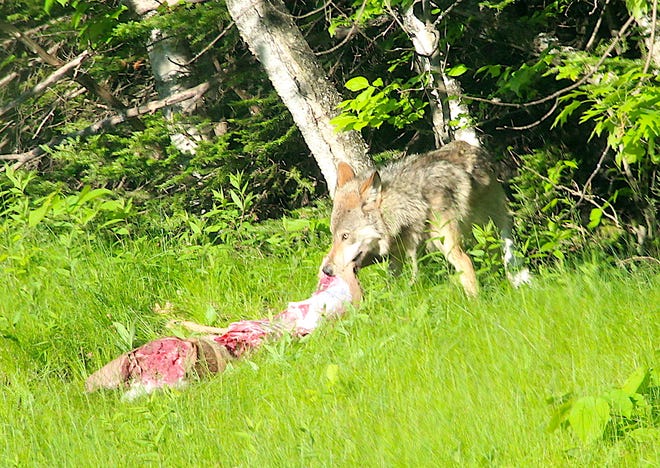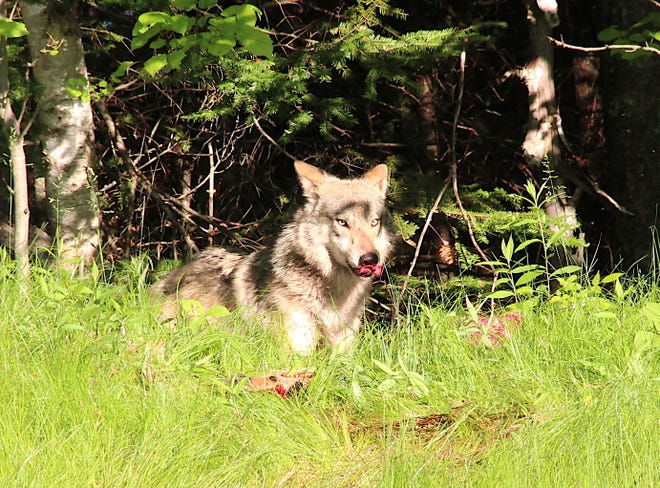Paul A. Smith Milwaukee Journal Sentinel
LEONA – The drive north is never dull.
But sometimes it’s incredible.
That was the case June 6 when I left southeastern Wisconsin at 3:30 a.m. bound for a goshawk research story in the Chequamegon-Nicolet National Forest.
Things started to get interesting as dawn spread pink light across the Wisconsin landscape and wildlife sightings cascaded into view.
Near Black Creek a pair of sandhill crane adults walked with two tiny colts through a greening farm field. Every few steps, the adults, then the youngsters, pecked a morsel of food from the ground. The learning had begun.
A bit farther north a strutting tom turkey displayed for three hens. For the record, the females had their heads down, constantly feeding, and seemed to be saying “breeding season is over.” But the persistence and spectacular sight of the longbeard impressed me, even as I sped north at 55 mph.
Near Bonduel a flock of Canada geese rested in a small wetland, possibly preparing for their molt migration.
Like any drive on Wisconsin roads, there were plenty of dead animal sightings, too. I lost count of the number of vehicle-killed raccoons, opossums, groundhogs and white-tailed deer I passed.
Near Mountain a mature bald eagle flapped up as I approached; it had been feeding on a dead deer on the shoulder of the highway. The big, regal-looking bird flew a short distance and landed in a red pine. It would likely be back down to scavenge the rest of its meal as soon as the coast was clear.
All those sights were familiar to me.
But about 6:40 a.m. on Highway 8 just north of Laona I came across something I’d never seen.
The road grade in this stretch sits low; grass-covered hills rise on each side about 25 yards to the forest.
The sun had crested the trees and bright light flooded onto the western side of the highway.
As I motored north, the form of a large gray animal dominated the grassy field to my left.
It was a wolf, and it was laboring to move something.
The sight struck me with the force of an exploding air bag.
I slowed to a stop, did a U-turn, grabbed my camera and drove back. Get the Coronavirus Watch newsletter in your inbox.
Updates on how the coronavirus is affecting your community and the nationDelivery: VariesYour Email
I began taking photos even before the passenger-side window was down.
The wolf had its jaws latched onto something and was yanking it, a foot or so at a time, uphill. The drag line was visible as a red, zig-zag smear up the incline.
It was now clear what the wolf had: a deer carcass.

I put the vehicle in park just off the pavement; the wolf was about 35 yards to the southwest.
The wolf eyed me warily, then let go of the deer and retreated to the edge of the forest.
It sat down, half in shade and half in sun, mouth open and panting, and briefly rested.
I could hardly believe what I was seeing. This was the 13th wolf I had observed in Wisconsin, but the first involved in such a behavior.
And most of my wolf sightings had been fleeting glances at a fleeing animal.
This wolf was engaged in pulling a deer bigger than itself to a safe place for a meal.
Was it a car-killed deer? Probably. The bloody track in the grass extended down to the edge of the road.
But it was certainly fresh. The deer had died, by wolf or Detroit steel, in the last couple hours.
June is one of the peaks of car-deer collisions in Wisconsin, and the animal appeared to be an adult doe.
Most animals that die after getting hit by vehicles on Wisconsin roads sit for far too long before they either decompose or are finally picked up by highway crews.
This wolf was doing a service by removing it, I thought. And putting it to excellent use.
As a big game hunter, I have had occasion to drag deer uphill.
As the wolf sat there, open-mouthed from exertion, I said aloud “I know how you feel.”
It didn’t take much of a break, however. After just 20 seconds the wolf walked back to the carcass and latched on again.
Pulling backward, it braced its hindquarters and used its neck and shoulders to jerk the deer through the grass.
It pulled a few times, then appeared to take a bite and sat next to the carcass. The wolf now had its meal at the edge of the forest; it appeared to relax a bit.

I took another dozen or so photos. Then the wolf resumed the drag, and a moment later it melted into the deep shade and out of view completely.
The entire encounter lasted 90 seconds; I captured 30 images.
I felt extremely fortunate to have passed through just in time to see the spectacle.
Afterward I shared photos of the encounter with Adrian Wydeven, who headed up the wolf program for the Wisconsin Department of Natural Resources from 1990-2013.
Wydeven is on the short list of people who have handled and observed the most wolves in the state.
He said he’d never seen a wolf dragging a deer; mostly they eat them where they lay.
As far as pulling the deer into the forest, he said it seemed like a logical thing for the wolf to do.
“Often they will just feed on deer carcasses on road shoulders, but during the daytime would be more hazardous,” Wydeven said. “Pulling it in the woods also gets it away from ravens, vultures and eagles.”
Adult deer are harder for wolves to kill in mid-summer when deer are in good condition, so a road kill would be an easy meal, Wydeven said. If it was a lone wolf, they tend not to be as good hunters, and rely more on road kills.
Wydeven said the wolf in the photos appeared to be an adult, probably at least 2 years old, and likely weighs about 80 pounds.
If it was an adult with pups, in early June it would likely eat as much of the deer as possible (perhaps 20 pounds) and then return to the den or rendezvous site to regurgitate the meat for its pups, and possibly its mate.
It then would likely return to the carcass, probably at night, to feed again, Wydeven said.
The 2019-20 Wisconsin wolf tracking survey has yet to release its results. Last year Wisconsin had a minimum count of 914 wolves and 248 wolf packs, according to the DNR’s annual report.
In spring, wildlife experts say the number of wolves typically doubles as pups are born, then begins to decline through the year due to various sources of mortality.
So I saw one of the 2,000 or so wolves in Wisconsin, and I observed it engaged in a unique behavior.
Many Wisconsinites love to debate wolf numbers, but this is certain: I felt as rich as a lottery winner to have crossed paths with this wolf near Laona.
It, and the rest of its species, are an undeniable asset to the state’s ecosystem. On rare occasions, they create an unforgettable road trip, too.
